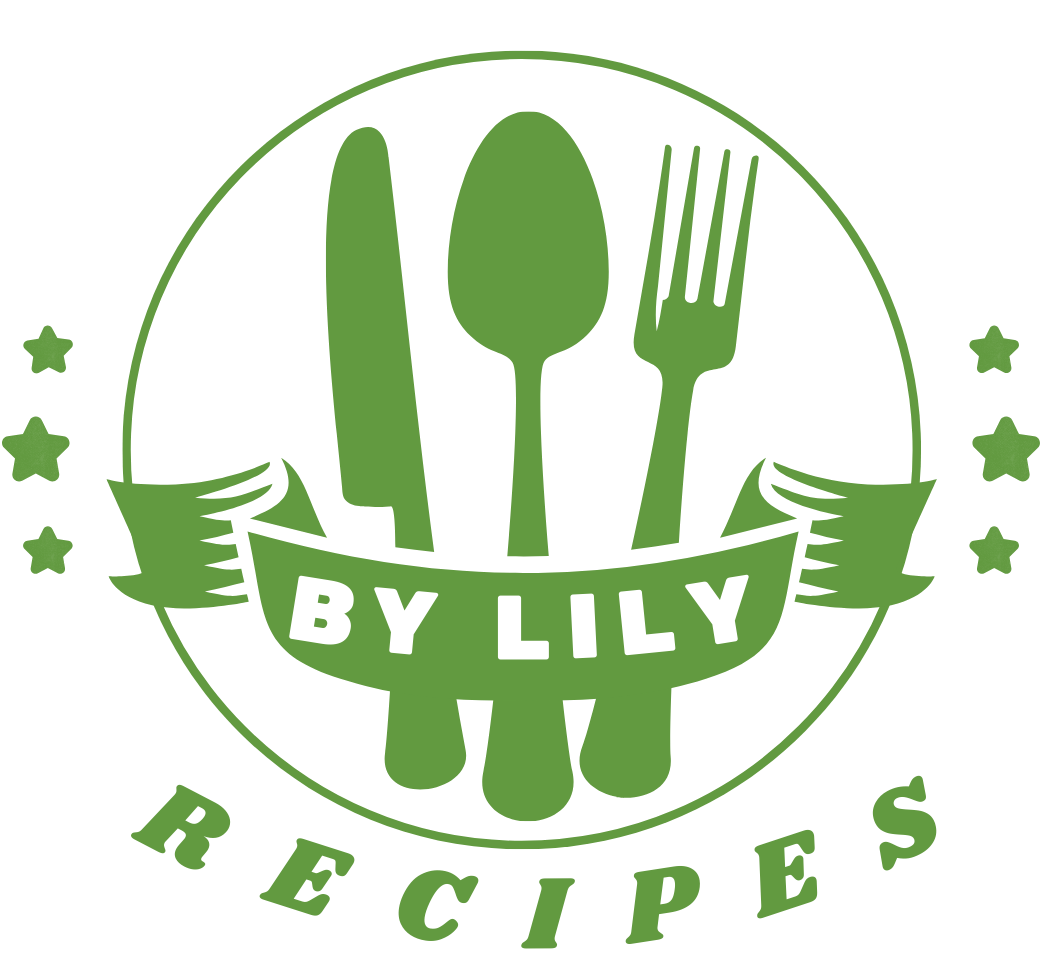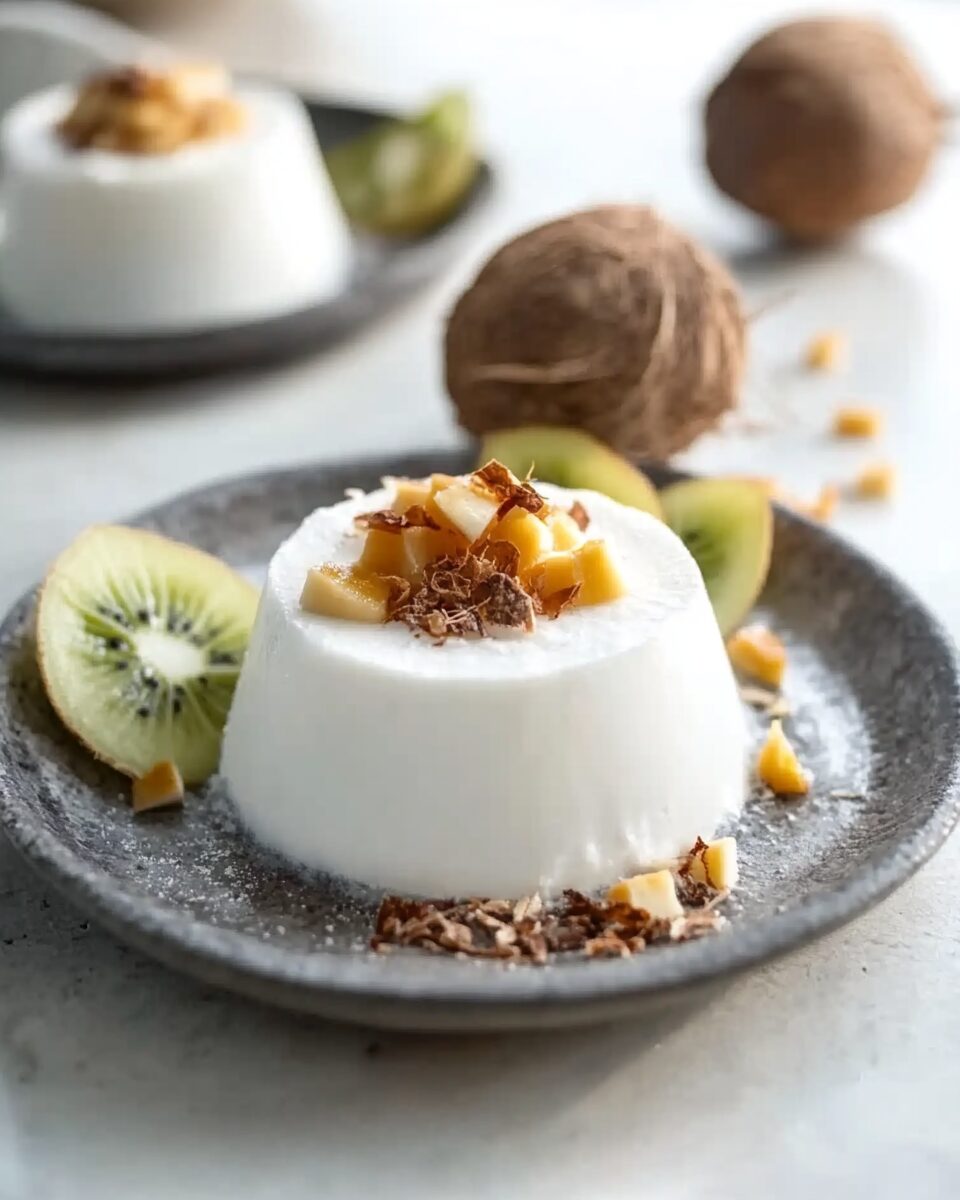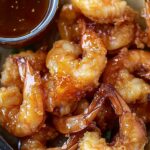Coconut Panna Cotta is a creamy, dairy-free dessert with a tropical twist. Made from coconut milk, coconut cream, sugar, and gelatin, this silky-smooth treat is perfect for dinner parties or special occasions. It is served with fresh tropical fruits and Filipino latik (fried coconut curds) for added flavor and texture.
Full Recipe:
Ingredients
Coconut Panna Cotta:
- 1 packet (0.25 oz) unflavored gelatin powder (about 1 tablespoon)
- 1 tablespoon water
- 2 ¼ cups canned full-fat unsweetened coconut milk
- ¾ cup canned unsweetened coconut cream
- ¼ cup granulated sugar
Latik (Optional Topping):
- 1 can (14 oz) unsweetened coconut cream or coconut milk
Additional Toppings:
- Golden kiwi
- Green kiwi
- Mango
Directions
Coconut Panna Cotta:
- Lightly grease ramekins or serving vessels with coconut oil. Set aside.
- In a small bowl, combine gelatin powder with water, stir, and let sit for 5 minutes to bloom.
- In a medium saucepan over medium heat, combine coconut milk, coconut cream, and sugar. Bring to a simmer and stir until sugar dissolves. Remove from heat and let cool for 5-8 minutes.
- Stir in the bloomed gelatin until fully dissolved.
- Pour the mixture into prepared ramekins. Let cool to room temperature, then refrigerate for at least 6 hours (overnight is best).
- To unmold, dip ramekins into warm water for 3-5 seconds, then invert onto a plate. Garnish with fruits and latik.
Latik:
- Pour well-shaken coconut milk into a shallow pan over medium heat.
- Simmer until the water evaporates and the mixture thickens.
- As the coconut oil separates, the coconut milk solids (curds) will start to form.
- Continue cooking until the curds turn golden brown. Strain and separate the coconut oil from the latik.
- Use latik immediately or store in the fridge.
Nutrients (Per Serving – Approximate)
- Calories: 343 kcal
- Carbohydrates: 15g
- Protein: 4g
- Fat: 32g
- Saturated Fat: 28g
- Sodium: 17mg
- Potassium: 335mg
- Fiber: 3g
- Sugar: 11g
- Vitamin C: 3mg
- Calcium: 19mg
- Iron: 2mg
Enjoy this rich and tropical dessert with your favorite fruits! 🍍🥭
Origins of Panna Cotta
Panna Cotta, which means “cooked cream” in Italian, is a dessert that originated in the Piedmont region of Italy. Traditionally made with heavy cream, sugar, and gelatin, this dessert is known for its velvety texture and delicate flavor. Over time, variations of Panna Cotta have emerged, incorporating different flavors such as vanilla, chocolate, and fruit purees. The Coconut Panna Cotta is a modern twist on the classic, catering to those who prefer a dairy-free alternative while maintaining the dessert’s signature smoothness.
Why Choose Coconut Panna Cotta?
Coconut Panna Cotta stands out for several reasons. First, it is an excellent choice for those who are lactose intolerant or following a dairy-free diet. The use of coconut milk and coconut cream provides a rich and creamy texture without the need for heavy cream. Second, the coconut flavor pairs beautifully with a variety of tropical fruits, such as mango, kiwi, and pineapple, making it a versatile dessert. Finally, the simplicity of the recipe means that even beginner cooks can achieve a restaurant-quality dessert with minimal effort.
The Role of Gelatin in Panna Cotta
One of the key ingredients in Panna Cotta is gelatin, which acts as a stabilizer and gives the dessert its signature wobble. Gelatin is derived from animal collagen and is responsible for the delicate firmness of the dessert. When mixed with warm liquid, gelatin dissolves and sets as it cools, creating the perfect texture for Panna Cotta. For a vegetarian-friendly version, agar-agar, a seaweed-based thickener, can be used as a substitute. However, it is important to note that agar-agar sets more firmly than gelatin, resulting in a slightly different texture.
Enhancing Flavor with Latik
Latik is a traditional Filipino topping made from coconut milk or coconut cream. It is created by simmering coconut milk until the liquid evaporates, leaving behind golden brown curds that are rich in coconut flavor. The curds are then separated from the coconut oil and used as a topping for various Filipino desserts such as rice cakes and puddings. In Coconut Panna Cotta, latik adds a delightful crunch and an extra layer of coconut goodness that enhances the overall taste of the dessert.
Pairing Coconut Panna Cotta with Fruits
Fresh fruits are an excellent accompaniment to Coconut Panna Cotta, adding a burst of freshness and natural sweetness. Tropical fruits such as mango, kiwi, and golden kiwi complement the creamy texture of the dessert, balancing its richness with bright and tangy flavors. Other fruit options include passion fruit, papaya, and berries, all of which bring their unique characteristics to the dish. The contrast between the smooth Panna Cotta and the juicy fruits makes every bite a delightful experience.
Presentation and Serving Suggestions
Presentation plays a crucial role in making Coconut Panna Cotta an eye-catching dessert. Here are a few serving ideas to make it visually appealing:
- Unmolded Panna Cotta: If using ramekins, gently dip them in warm water before inverting onto a plate for a professional-looking presentation.
- Layered Desserts: Serve Panna Cotta in glasses or jars, layering it with fruit puree or compote for a visually stunning effect.
- Garnishes: Use toasted coconut flakes, edible flowers, or mint leaves to add color and texture to the dish.
- Drizzles: A drizzle of honey, caramel sauce, or even a splash of coconut milk can enhance the flavors further.
Nutritional Benefits of Coconut Panna Cotta
Coconut Panna Cotta not only satisfies your sweet tooth but also provides some nutritional benefits. Coconut milk and coconut cream are rich in healthy fats, which can help provide long-lasting energy. They also contain lauric acid, known for its antimicrobial properties. Additionally, coconut is a good source of potassium and magnesium, essential minerals that support heart health. When paired with fresh fruits, the dessert provides fiber, vitamins, and antioxidants that contribute to overall well-being.
Tips for Perfect Coconut Panna Cotta
To achieve the best results when making Coconut Panna Cotta, consider the following tips:
- Use Full-Fat Coconut Milk and Cream: This ensures a rich and creamy texture.
- Dissolve Gelatin Properly: Bloom the gelatin in water before adding it to the warm coconut mixture to prevent clumps.
- Avoid Boiling the Mixture: Overheating the coconut milk can affect the final texture of the dessert.
- Chill Overnight: While six hours is sufficient, chilling overnight allows the flavors to fully develop and the Panna Cotta to set perfectly.
- Experiment with Flavors: Add vanilla extract, pandan essence, or even a touch of rum for a unique twist on the classic recipe.
Cultural Significance of Coconut-Based Desserts
Coconut-based desserts hold cultural significance in many tropical regions, especially in Southeast Asia and the Pacific Islands. In the Philippines, coconut is a staple ingredient in various sweets, from rice cakes to custards. In Thailand, coconut milk is used in desserts like sticky rice with mango. The versatility of coconut makes it an essential component in traditional and modern desserts worldwide. Coconut Panna Cotta bridges the gap between classic Italian cuisine and tropical flavors, making it a delightful fusion dish.
Conclusion
Coconut Panna Cotta is a testament to the beauty of simple ingredients coming together to create an elegant and delicious dessert. Its smooth, creamy texture, combined with the tropical flavors of coconut and fresh fruits, makes it a standout treat for any occasion. The addition of latik provides a delightful crunch and enhances the overall coconut experience. Whether you’re looking for a dairy-free alternative to traditional Panna Cotta or simply want to indulge in a tropical-inspired dessert, Coconut Panna Cotta is a must-try. With its easy preparation, impressive presentation, and delightful taste, this dessert is bound to become a favorite among both home cooks and professional chefs alike.






